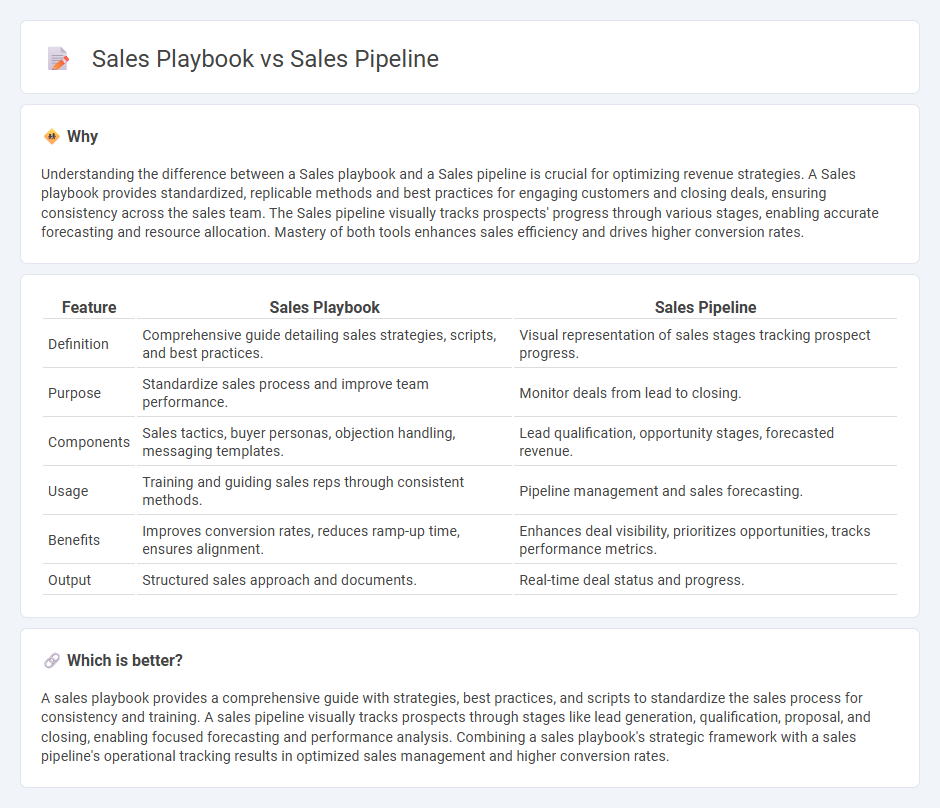
A Sales playbook provides a comprehensive guide outlining strategies, best practices, and processes to optimize sales team performance. The Sales pipeline visually tracks each stage of the customer journey, from lead generation to deal closure, helping to forecast revenue and identify bottlenecks. Explore this resource to understand how integrating a sales playbook with your sales pipeline can drive consistent revenue growth.
Why it is important
Understanding the difference between a Sales playbook and a Sales pipeline is crucial for optimizing revenue strategies. A Sales playbook provides standardized, replicable methods and best practices for engaging customers and closing deals, ensuring consistency across the sales team. The Sales pipeline visually tracks prospects' progress through various stages, enabling accurate forecasting and resource allocation. Mastery of both tools enhances sales efficiency and drives higher conversion rates.
Comparison Table
| Feature | Sales Playbook | Sales Pipeline |
|---|---|---|
| Definition | Comprehensive guide detailing sales strategies, scripts, and best practices. | Visual representation of sales stages tracking prospect progress. |
| Purpose | Standardize sales process and improve team performance. | Monitor deals from lead to closing. |
| Components | Sales tactics, buyer personas, objection handling, messaging templates. | Lead qualification, opportunity stages, forecasted revenue. |
| Usage | Training and guiding sales reps through consistent methods. | Pipeline management and sales forecasting. |
| Benefits | Improves conversion rates, reduces ramp-up time, ensures alignment. | Enhances deal visibility, prioritizes opportunities, tracks performance metrics. |
| Output | Structured sales approach and documents. | Real-time deal status and progress. |
Which is better?
A sales playbook provides a comprehensive guide with strategies, best practices, and scripts to standardize the sales process for consistency and training. A sales pipeline visually tracks prospects through stages like lead generation, qualification, proposal, and closing, enabling focused forecasting and performance analysis. Combining a sales playbook's strategic framework with a sales pipeline's operational tracking results in optimized sales management and higher conversion rates.
Connection
A sales playbook provides structured strategies and best practices that guide sales representatives through each stage of the sales pipeline, ensuring consistent and effective customer interactions. The sales pipeline visually tracks the progress of potential deals from lead generation to closing, enabling measurement and optimization based on the playbook's methodologies. Integrating these tools enhances forecasting accuracy, accelerates deal closure rates, and improves overall sales performance.
Key Terms
Sales pipeline:
The sales pipeline is a visual representation of the sales process that tracks potential customers through stages such as prospecting, qualification, proposal, and closing. It provides sales teams with a clear overview of where each lead stands, enabling better forecasting and resource allocation. Discover how optimizing your sales pipeline can drive higher conversion rates and revenue growth.
Stages
Sales pipeline stages outline the sequential steps a prospect moves through, from lead generation to closing a deal, ensuring systematic tracking of sales progress. Sales playbook stages, however, detail the tactical actions, messaging, and best practices sales reps employ at each phase to effectively engage prospects and convert opportunities. Discover how optimizing both sales pipeline and playbook stages can enhance your revenue growth strategy.
Conversion rate
Sales pipeline visualizes stages from lead generation to deal closure, tracking opportunities and conversion rates at each phase to identify bottlenecks and improve sales efficiency. Sales playbook provides structured sales strategies, scripts, and best practices designed to optimize sales reps' interactions and boost conversion rates through consistent messaging. Explore how integrating a sales pipeline with a sales playbook can enhance overall conversion rates and sales performance.
Source and External Links
What is a Sales Pipeline? And How Do You Build One? - Salesforce - A sales pipeline is a visual representation of where each prospect is in the sales process, tracking their progress through stages like prospecting, lead qualification, sales call, proposal, negotiation, contract signing, and post-purchase to manage and optimize sales efforts effectively.
What is a sales pipeline? | Definition from TechTarget - A sales pipeline visually shows where prospects are in the purchasing process, helping sales reps and managers forecast deal closures and sales quotas by tracking stages such as lead gathering, qualification, relationship building, and deal closing, often managed via CRM software.
Building a Sales Pipeline: Ultimate Guide - Pipedrive - A sales pipeline is an organized visual system for tracking potential buyers through defined stages of the sales process aligned with your target audience and sales activities, enabling sales reps to consistently close deals by following a structured workflow.
 dowidth.com
dowidth.com